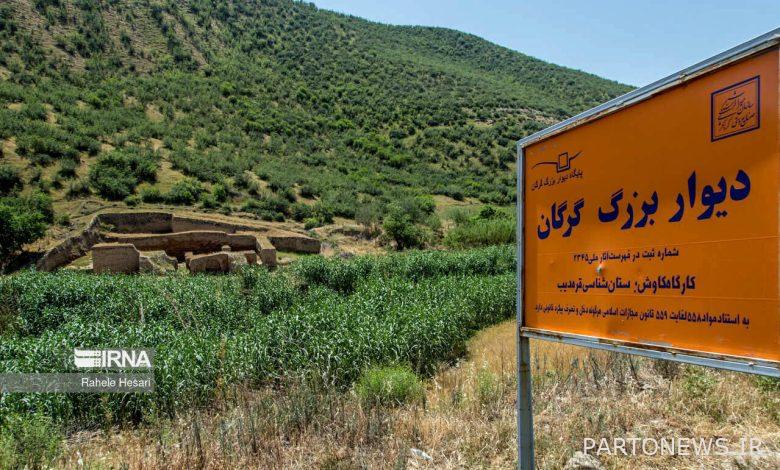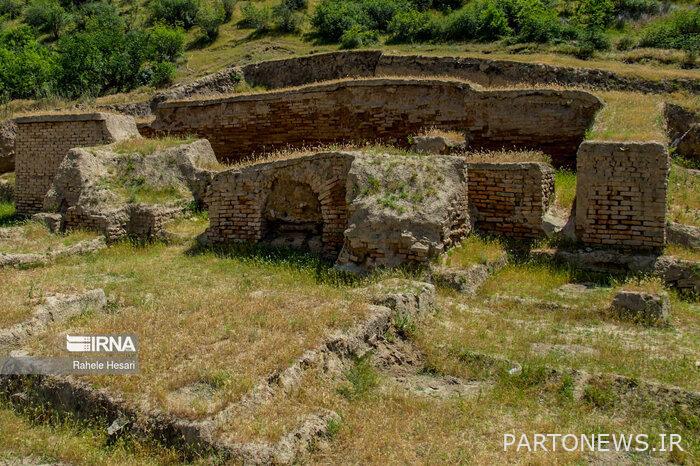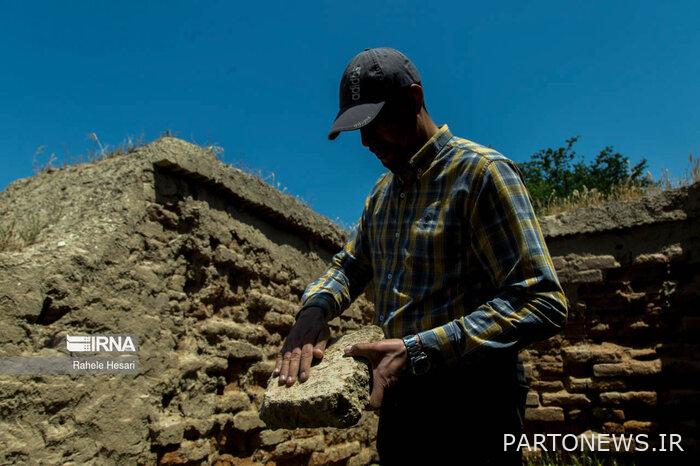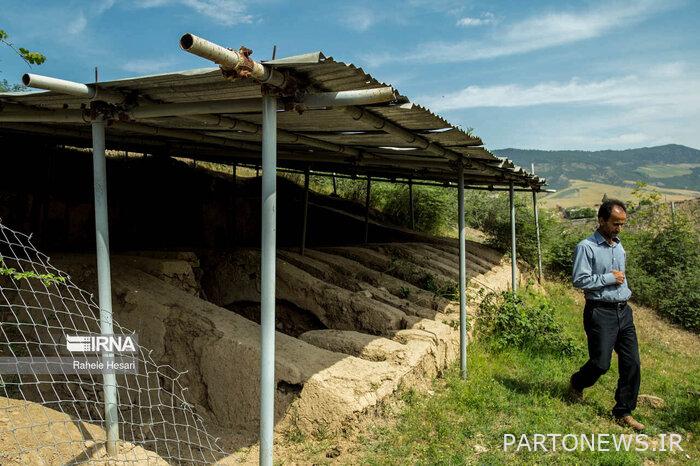The Red Wall, a relic of the Sassanids in Golestan

The Great Wall of Gorgan or the Red Wall is an instructive relic of the Sassanids in the east of Golestan to protect the borders against the invasion of invading tribes; A valuable historical work that, despite the destruction of large parts of it; It is a symbol of Iranians’ love for thousands of years for the stability of the borders of this ancient land.
The historic wall of Gorgan and its related facilities are among the masterpieces of military engineering of the Sassanid Empire in the cultural area of North-Eastern Iran, in order to prevent the invasion of Central Asian desert tribes and to guard the borders of the country, the Silk Road and the security and comfort of the people of the region with materials Clay and brick were built, which in historical sources are named “Darband Gorgan, Darband Khazran, Bab al-Abowab, Iran and Turan Dam, Yagoj and Magog Dam, Iskander Dam, Pirouz Dam, Khosrow Dam, Anoushirvan Dam, Qezal Alan and Marsrokh Dam” from It is remembered.

The historic wall of Gorgan is a relic from the Sassanid era
Many Iranian and non-Iranian researchers have studied the subject of the Great Wall of Gorgan, but for the first time in 1310, the American Eric Schmidt managed to identify 170 kilometers of the Great Wall of Gorgan and related facilities by flying over the cities of Iran and the Gorgan Plain and created the necessary foundation for provided extensive archaeological studies.
In the 1350s, the late Mohammad Yusuf Kiani, the head of the archeological excavation team of the Gorgan plain, by flying again over the Great Wall of Gorgan, succeeded in identifying the route of the Great Wall of Gorgan and related facilities from the eastern shores of the Caspian Sea to the Pishkemar mountains in the heights known as Arabdagh. This aerial survey, with the cooperation of the late Mohammad Mehyar, led to the presentation of the first route map of the Great Wall of Gorgan and related facilities and the publication of the results of the first exploration of this wall.
Today, the remains of the historical wall can be seen from the eastern shores of the Caspian Sea to the heights and valleys of the Eastern Alborz in the slopes of Beili Koh (Golestan National Park near the village of “Zaw” in the northeast of Kalaleh).
The Great Wall of Gorgan has a length of 200 kilometers with an average width of 2.5 meters, based on the results of archaeological excavations, it was built with brick and mud mortar materials, and in some historical sources, the height of this wall is stated to be 8 to 10 meters.
This wall includes a moat, brick kilns, earthen dam, water supply channels, 38 forts attached to the wall, four guard towers and more than 25 city forts as part of the military strength and fortifications of the Sassanid Empire, an important role in confronting the enemy and ensuring the security of trade routes. And the peace of the people of the region.
This wall, which was nationally registered in 2007, starts from the Glidagh Mountains in Marawa Tepe and continues to the shores of Gamishan, and it is considered the third longest wall in the world after the historical wall of China with 6 thousand kilometers and the German wall with about 550 kilometers. At the time of its establishment, it had various uses, including defense and military.
Currently, there are no remains of the historical wall of Gorgan, except in a limited way in the eastern areas, and most of it is buried under the soil.

Revival of the historical wall of Gorgan is effective in strengthening tourism and increasing social vitality
The historic wall of Gorgan is considered as a relic left over from the Sassanid Empire era, including an important heritage introducing a corner of the rich and ancient history of Iran, the activities focusing on its study, protection, restoration and restoration in the east-west direction of the province can provide the background To attract more tourists to Golestan and ultimately lead to an increase in social vitality in the society.
In an interview with IRNA reporter, the director of Gorgan Great Wall base stated: Since 1378, the project of examining the condition of Gorgan’s historical wall started with the approach of “study, protection, restoration and restoration”.
Hamid Omrani Rakavandi added: Good works were done in the field of study and archeology and archeology information was almost completed in these few years, but we did not perform well in the field of protection, and the restoration and restoration of the historical wall of Gorgan has not been seriously entered yet.
He continued: In the previous years, seven billion Tomans were approved for this wall, and by allocating this amount, the aerial mapping of the historical wall of Gorgan was started and the preliminary file of its global registration was also prepared.
Emphasizing the planning to create five information centers on the way to the historic wall of Gorgan, he said: The construction of the first information center has started in the area of Gemishan’s Qelajig Bozor village and has achieved 40% physical progress so far.
The director of the Gorgan Great Wall base added: During the visit of the president of the 13th government to Golestan province in 1400, seven billion tomans were approved for this historical work, which we are continuing to allocate and we are trying, considering the increase in costs in the second round of Ayatollah Raisi’s visit with the approval 50 billion tomans for this wall, we can organize the protection, restoration and restoration program and most importantly complete the global registration file, compile the management plan and complete the information base of the wall to a desirable end.
Omrani considered restoration and restoration of the excavation workshop of the historical wall of Gorgan in Kalaleh city as one of the other programs of this base and said: So far, 2 thousand square meters of excavation has been done in this workshop for excavation and archeology work, and if the required credit is approved in the round Second, the provincial trip of the government delegation of these excavations will continue.
He emphasized: By carrying out these excavations to obtain the remnants of that era, including parts of the wall, brick kilns and military facilities, it is possible to create a better environment for the visitors of the historical wall of Gorgan as one of the biggest identity heritages of Iran.
Omrani announced that the establishment of tourist camps with facilities such as toilets, prayer rooms, and spaces for rest and purchase of essential items is effective in increasing the length of time tourists stay on the path of the historical wall of Gorgan and stated: The preliminary file for the world registration of this historic monument in UNESCO has been approved and the measures for The file is being completed.
He continued: Completing the case includes preparing the infrastructure for the presence of tourists by completing the mapping, installing signboards and creating tourist complexes (hotels, camps, restaurants and ecotourism) along the wall route.

The historical wall of Gorgan is the center of development of Golestan province
The director of the Gorgan Great Wall base said: This historical work has a good capacity to be proposed as a center for the development of Golestan province due to its extension from east to west of the province and passing through seven cities along the way.
Omrani added: By creating the necessary infrastructure, after visiting the historical wall of Gorgan, tourists will get to know the cultural capacities and natural and historical attractions, handicrafts and local foods, customs and music of the Turkmen, Baloch and Sistani ethnic groups along the way.
He continued: Agriculture, fish farming, camel breeding and horse riding are other economic capacities of the cities along the Gorgan Wall route, which should be properly introduced so that tourists after visiting this wall will be able to see other attractions of the province, including Qaboos Tower as the tallest tower in Tama. Ajri Jahan or visit the historical city of Jurjan.
Golestan is one of the northern and tourism provinces of Iran, which is located next to the Caspian Sea, the country of Turkmenistan, the provinces of North Khorasan, Semnan and the eastern slopes of Alborz and Mazandaran, and every year a large number of tourists and travelers come to stay or continue their journey in this province. And they choose its paths.
This province with an area of more than 20 thousand square kilometers has a population of about two million people who live in 34 cities and about a thousand villages.
Golestan, located between the two tourist poles of the north of the country and the pilgrimage site of Mashhad to Iran’s Nagaristan, is also a city and houses many ethnic groups, including Persians, Turkmen, Sistani, Turks (Azerbaijani and Qazalbash), Mazandaranis, Baluj and Kazakhs.

